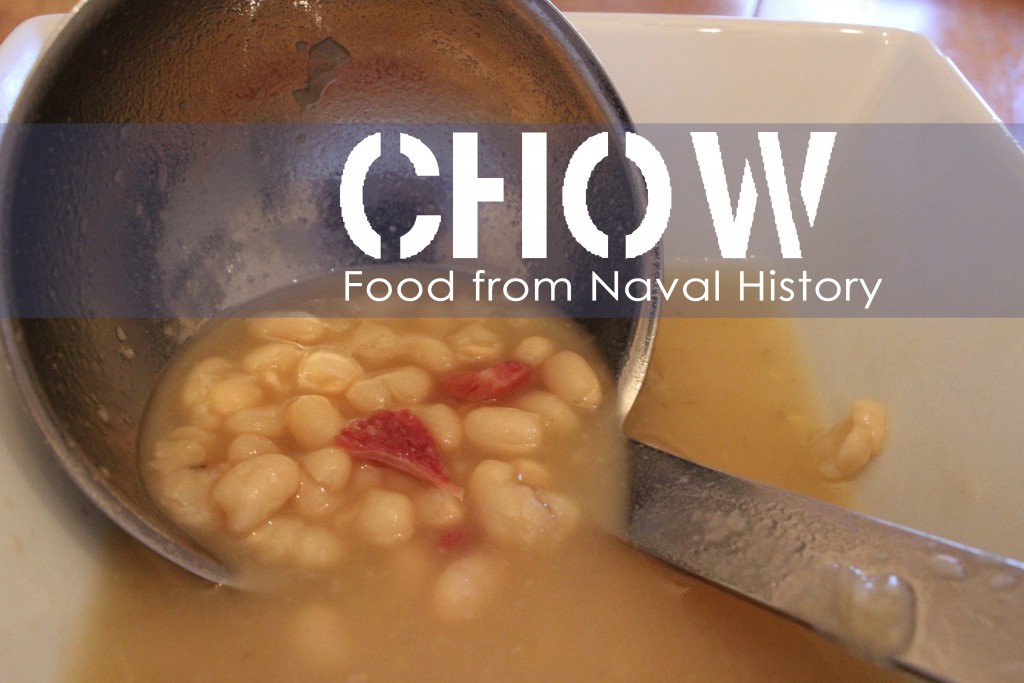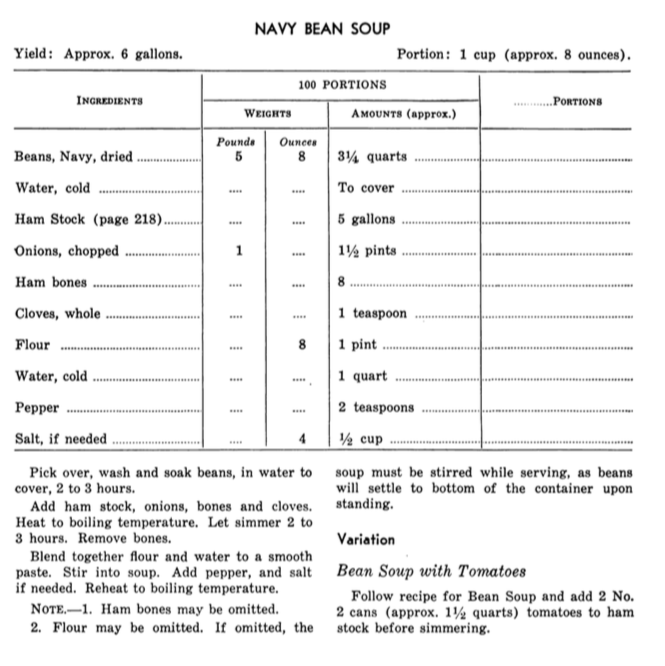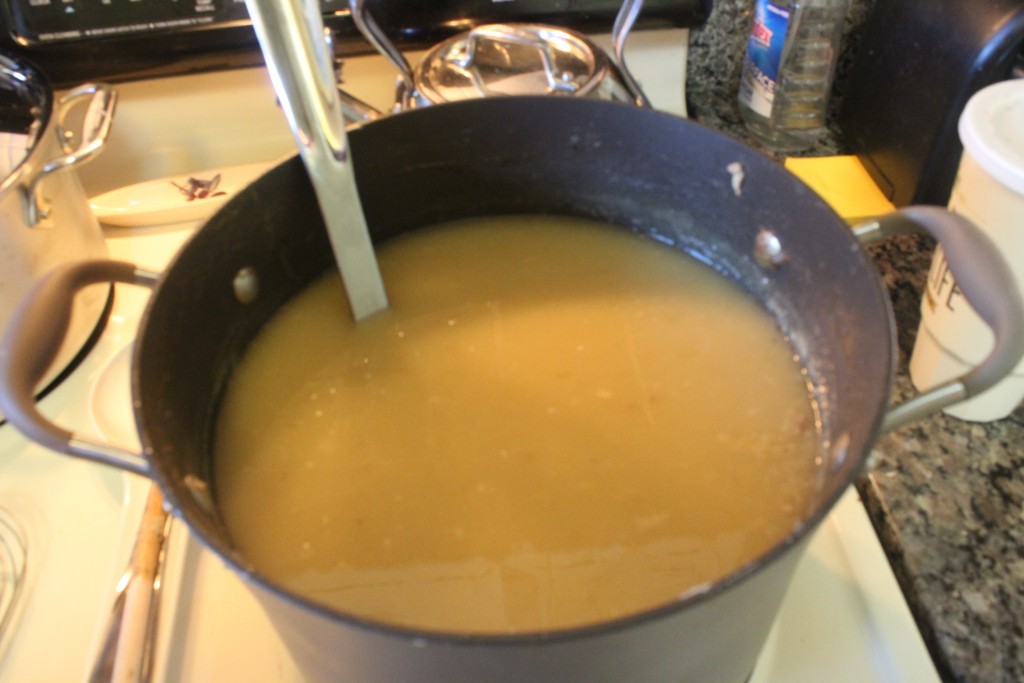 CHOW is a new blog and video series exploring the history behind U.S. Navy culinary traditions. See our first story on “Creamed Sliced Dried Beef” AKA S.O.S. here.
CHOW is a new blog and video series exploring the history behind U.S. Navy culinary traditions. See our first story on “Creamed Sliced Dried Beef” AKA S.O.S. here.
By Matthew T. Eng
Tucked away on the Naval History and Heritage Command’s website is a small section on the food Sailors ate aboard ship throughout the history of the United States Navy. Under “traditional Navy recipes,” NHHC gives three staple recipes from the 1958 Navy Cook Book: baking powder biscuits, creamed sliced dried beef, and Navy bean soup. In case you haven’t read our previous post for CHOW, we have already tackled one of these for our first project (creamed sliced dried beef). After all that thick gravy, I was feeling more like soup than biscuits.
It’s a common dish, readily available in many cafeterias, mess decks, or Easter dinner tables. You see the same type of beans used for game day cookouts (both baked and barbecued) and inside tinned cans with tiny pieces of pork. Among these dishes, Navy bean soup highlight’s the legume’s true potential. It’s hard to believe such a simple soup could bring about so many complex flavors. Navy bean soup, or its many variations, has developed over the last two centuries into an iconic American dish. The bean itself is native to the Americas. And like any good Sailor worth his/her salt, the bean is resilient: hardened and strong, they are able to endure severe temperatures. Maybe that is why, albeit unconfirmed, many attribute the name of the soup to the United States Navy, whose cooks have served it to sailors since the 19th century.
The most common name for navy bean soup is “Senate Bean Soup,” which has been a fixture in the Senate cafeteria since the early twentieth century. Other recipes in cookbooks and online refer to it simply as “ham bone soup.” Whatever it is called, ham hocks and ham bones are the feature ingredient for flavor. That key component may be the only thing that can get approval from both sides of the political spectrum, inside the Dirksen Building Cafeteria at least.
The Navy couldn’t seem to make up its mind for a soup name either, let alone a consistent recipe. Because of the surge in popularity at the beginning of the twentieth century, I decided to comb through turn-of-the-century Navy cook books to find the origin of the recipe. The first one I could find was from the 1902 General Mess Manual and Cook Book. Although Navy bean soup is not specifically mentioned, there is a recipe (the first one on the list of soups) for a “bean soup with salt pork.” The recipe used large amounts of fresh water to dilute the salt pork overnight before adding the boiling beans. The recipe was simply that: boiled pork and boiled beans in water, served with stale bread browned in a pan to be added to the soup mixture. Most of the soup recipes from that era were as no frills as the boiled bean soup.
Recipes improved in the proceeding decades. Although the same principle for preparation existed, room for improvement was clearly evident. The 1920 U.S. Navy Cook Book features a recipe for “bean soup.” The soup, prepared by soaking beans in cold water and boiling slowly in ham stock or ham bones. Unlike most Navy bean soups served today, the 1902 version from the U.S. Navy Cook Book included a hefty portion of tomatoes (12 lbs.), used to simmer in the soup one hour before service. Cook books refer to this style as “old fashioned” bean soup. The many variations to the traditional soup reminds me of the various ways people in New England take their clam chowder. By the time of the Second World War, a more standardized version of what we now now today as Navy bean soup came about. By 1958, tomatoes were only used as a “variation” to the Navy bean soup recipe.
Like the previous recipe, I decided to use the recipe from the 1944 Cook Book of the United States Navy.
 I showed the 1944 recipe to my father-in-law, a Navy veteran from over thirty years in the service. “Yeah, that looks about right,” he said. “I remember whenever we had Navy bean soup in the mess decks, you wanted to make sure you didn’t have the bottom rack.” Fiber can do wondrous things.
I showed the 1944 recipe to my father-in-law, a Navy veteran from over thirty years in the service. “Yeah, that looks about right,” he said. “I remember whenever we had Navy bean soup in the mess decks, you wanted to make sure you didn’t have the bottom rack.” Fiber can do wondrous things.
TASTING HISTORY
Because I never planned to make over six gallons of soup on my own, I had to once again scale down the recipe thanks to the STEM project created by teacher Greg Felber of Ledyard Middle School. Because I wanted to have enough soup for people to hopefully taste after I finished the project, I decided to make a quarter (1/4) of the full recipe. Could I make enough to feed 25 people using conventional pots and pans? After all, the goal is to get the rest of America making these recipes. It’s a lot of beans. A LOT. The math was a lot easier this time, thankfully. All I had to do was divide by four.
There was only one problem after I made all of the conversions: getting the materials to make it. The vegetables were easy enough. As I came to find out, obtaining the meat was more difficult than I expected. The recipe called for four ham bones. I looked around and could not find a definitive size of each bone. After more looking, I couldn’t find a ham bone PERIOD.
I looked everywhere for a ham bone. One supermarket would say they only had smoked ham hocks. Another one flat out said no. I went to two butchers, both of which had no ham bones to give me. Finally, I found a shop that served nothing but ham. They had to have it. Thankfully they did. I don’t know how readily available ham bones are in the U.S. Navy, but they are scarce in civilian life. I thanked them profusely on the phone and went to pick up the bones. Each of the bones were monstrous. I made the decision to substitute two bones for one of the bones that would make Fred Flintstone blush. That way, I only needed two ham bones for the full recipe (ham stock and soup).
The quarter recipe was as follows:
Ham Stock:
2 small or 1 large ham bone
2 gallons water
1 chopped onion
3/4 cup chopped celery
1 and 1/4 cup carrot
2 teaspoons salt
1/2 teaspoon pepper
1 bay leaf
Soup Preparation:
1.5 pounds Navy Beans
1.25 gallons Ham Stock (above)
1 onion, chopped
1 large ham bone (optional)
1/4 tsp. cloves
1/2 cup flour
2 cups water
Cooking: The Smell of Ham Everywhere
 Before I could begin to make the Navy bean soup, I had to make the stock. By my calculations, I needed at least a gallon and a half of stock to accommodate a quarter order of soup. After some slicing of vegetables customary for stock, I added the ham bone into the vat of water and let it do its things over the course of three hours. The smell of ham wafted out from my kitchen into the entire house. I’m not sure they make meat candles, but I imagine a ham flavored one would smell like my house as of late.
Before I could begin to make the Navy bean soup, I had to make the stock. By my calculations, I needed at least a gallon and a half of stock to accommodate a quarter order of soup. After some slicing of vegetables customary for stock, I added the ham bone into the vat of water and let it do its things over the course of three hours. The smell of ham wafted out from my kitchen into the entire house. I’m not sure they make meat candles, but I imagine a ham flavored one would smell like my house as of late.
When the stock was strained, I set it aside so I could wash and soak my pound and a half of Navy beans. Once they were property soaked and plump to the touch, I added the beans and another ham bone into the stock and let simmer for two hours. An onion and a small amount of cloves were also added. After two hours, some the beans appeared to be mashed and very tender. The soup was almost ready.
I added a slurry mix of flour and water into the soup to help it thicken up. Bringing it back to a boil, I lowered the temperature and served it. Bon appetit, Navy style.
The Taste Test
Admittedly, the taste was much more pleasant than the S.O.S. I previously ate. The ham flavor was strong, but not enough to be overwhelming. My wife also enjoyed it, commenting how the flavor was reminiscent of good southern soul cooking. Make sure you have a glass of water on hand and dig into this great Navy recipe.
The full video and recipe is shown below:


Pingback: CHOW: The (Navy) Daiquiri | Naval Historical Foundation
Sue Shipman
Admin
Teresa Pollock
Bob
Bobbie
Tom Hart
Lcdr Lee Siggers, USN(Ret)
Rick
G Brown, SK 2, ACB -1
Pingback: Navy Bean Soup Recipe - Cooking At Noon
Pete
Lee Paris